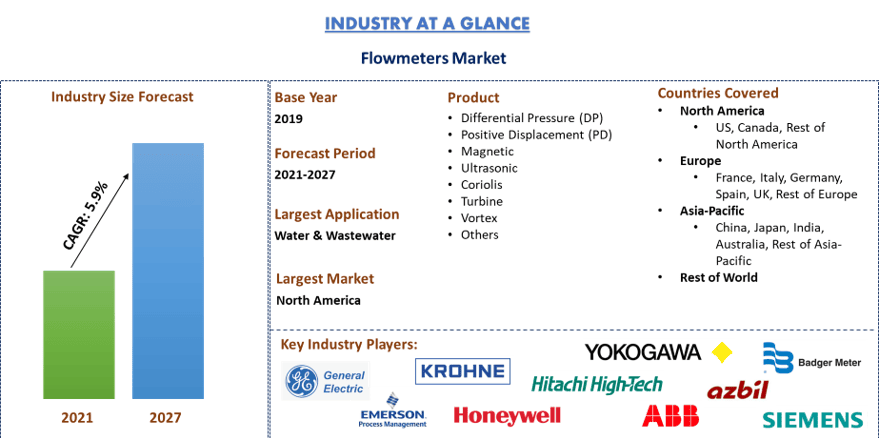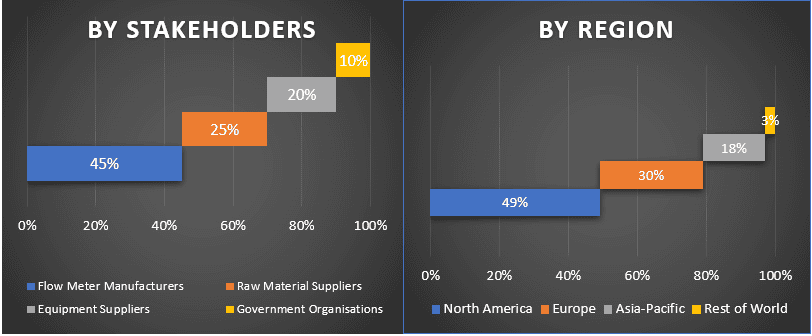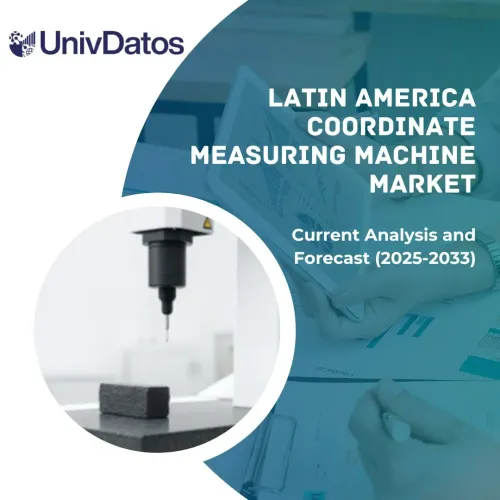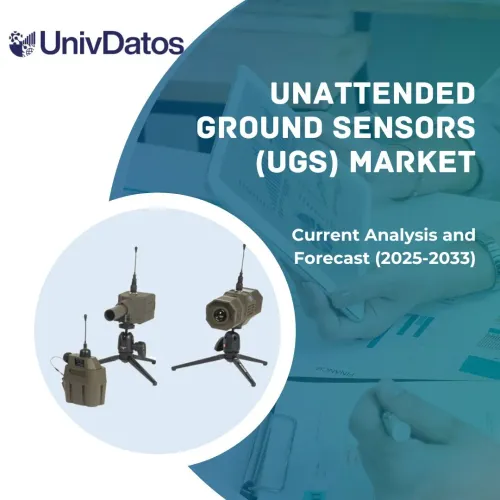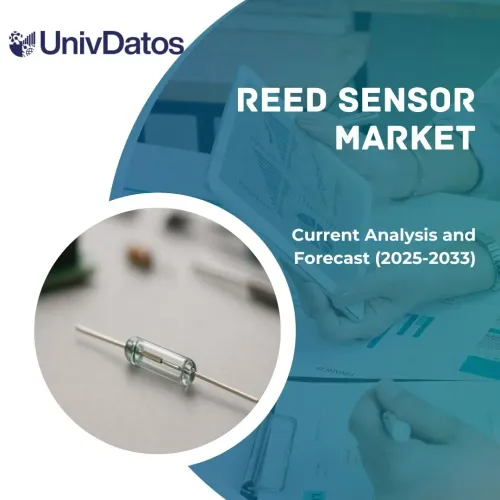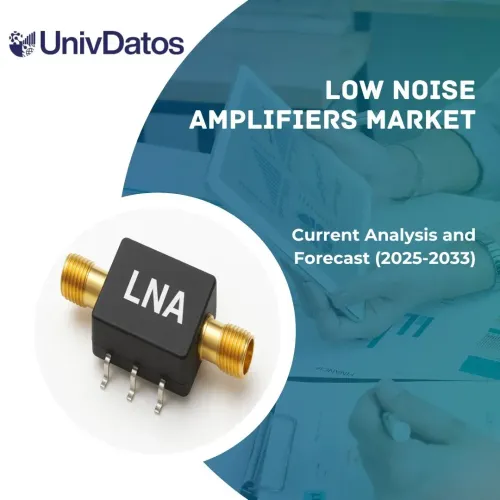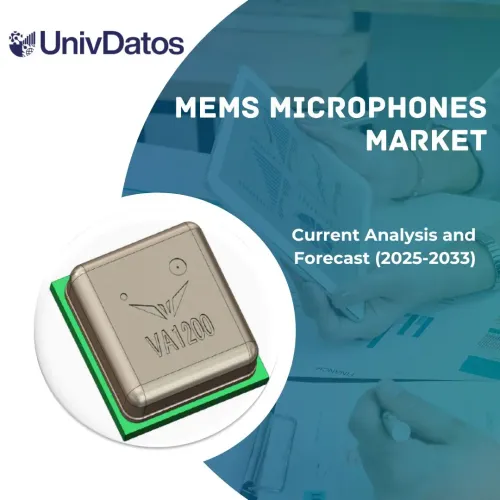- Home
- About Us
- Industry
- Services
- Reading
- Contact Us
Flowmeters Market: Current Analysis and Forecast (2021-2027)
Emphasis on Product (Differential Pressure (DP), Positive Displacement (PD), Magnetic, Ultrasonic, Coriolis, Turbine, Vortex, Others); Application (Water & Wastewater, Oil & Gas, Chemicals, Power Generation, Pulp & Paper, Food & Beverage, Others); and Region & Country.
Flowmeters Market is expected to exceed the market valuation of more than US$ 11.9 billion in 2027 and is expected to grow at a significant CAGR of 5.9% during the forecast period (2021-2027). Flowmeter is a device used to measure the mass or volume of a liquid or gas. There are many names for flowmeter including flow indicator, liquid meter, flow gauge, flow rate sensor, etc. depending on the industry in which it is being used. There is a huge market for flowmeters as they are used in a variety of industries. They can measure the linear, nonlinear, volumetric, or mass flow of a liquid or gas. Flowmeters are used to measure flow. They can also be used in open channels such as streams or rivers. More frequently, they are used to measure liquids and gasses flowing through a pipe. The best flow meters are the most accurate in measuring the precision, accuracy, and resolution of the fluids.
The industrial segment is the key factor influencing the flowmeters market growth. For example, in 2019, the IOGP production indicator reported a 91% increase in oil production and a 103% increase in gas production in the last 10 years in North America. This increase is likely to affect the number of flowmeters used in the industry, as the oil & gas industry is one of the highest users of flowmeters. Additionally, growth in other such industries is also influencing the overall market growth of the flowmeter market. For example, the natural gas production in the United States is expected to increase from 23 trillion cubic feet in 2011 to 33.1 trillion cubic feet in 2040, according to the paper published in the journal Sierra. Likewise, the food and beverage industry is forecasted to grow 7% from 2020-2026 in the United States. All this is influencing the growth of the flowmeter market.
Increase in Oxygen Consumption During the Pandemic (%), 2020
Emerson Electric Corporation, General Electric, Krohne Messtechnik GmbH, Hitachi High-Tech Corporation, ABB Ltd., Honeywell International Inc., Siemens Group, Yokogawa Electric Corporation, Azbil Corporation, Badger Meter, Inc. are some of the prominent players operating in the Flowmeters market. Several M&As along with partnerships have been undertaken by these players to facilitate customers with hi-tech and innovative products/technologies.
Insights Presented in the Report
“Amongst Products, Magnetic segment holds the major share”
Based on product, the flowmeters market is fragmented into differential pressure (DP), positive displacement (PD), magnetic, ultrasonic, coriolis, turbine, vortex, and others. The magnetic segment is further bifurcated into wired and wireless. The magnetic segment of the flow meters market was valued at US$ XX billion in 2020 and is likely to reach US$ XX billion by 2027 growing at a CAGR of XX% from 2021-2027. Magnetic flow meters or mag meters are cost-effective, bi-directional, obstruction less, and provide a highly accurate volumetric flow. All these qualities make magnetic flowmeters the most popular choice. Another commonly used flow meter is the coriolis, which is a tube energized by a fixed vibration.
“Amongst Application, Waste & Wastewater segment holds the major share”
Based on application, the flowmeter market is segmented into water & wastewater, oil & gas, chemicals, power generation, pulp & paper, food & beverage, and others. Water & wastewater accounted for a market valuation of US$ XX billion in 2020 and is expected to reach US$ XX billion by the year 2027, at a CAGR of XX% over the analyzed period. Flow meters are important for the availability of high-quality, clean water in commercial, industrial, and residential areas. Flow meters help in leak detection and pump flow management. Currently, 90% of the wastewater globally is collected and treated i.e., 31,000 m3/d. Further, the number of wastewater treatment facilities is constantly increasing with the increasing awareness about the environment. This is expected to boost the flowmeter market growth.
“North America represents one of the largest markets of Flow Meters market”
For a better understanding of the market dynamics of the Flowmeters market, a detailed analysis was conducted for different regions across the globe including North America (U.S, Canada, and the Rest of North America), Europe (Germany, France, Italy, United Kingdom, Spain, and Rest of Europe), Asia-Pacific (China, Japan, India, Australia, and Rest of APAC) and Rest of the World. North America dominated the market and grabbed around XX% market share owing to growing industrialization across the region.
Reasons to buy this report:
- The study includes market sizing and forecasting analysis validated by authenticated key industry experts
- The report presents a quick review of overall industry performance at one glance
- The report covers an in-depth analysis of prominent industry peers with a primary focus on key business financials, product portfolio, expansion strategies, and recent developments
- Detailed examination of drivers, restraints, key trends, and opportunities prevailing in the industry
- The study comprehensively covers the market across different segments
- Deep dive regional level analysis of the industry
Customization Options:
Flowmeters market can further be customized as per the requirement or any other market segment. Besides this, UMI understands that you may have your own business needs, hence feel free to connect with us to get a report that completely suits your requirements.
Table of Content
Analyzing the historical market, estimation of the current market, and forecasting the future market of the Flow Meters market were the three major steps undertaken to create and analyze the adoption of Flow Meters in major regions globally. Exhaustive secondary research was conducted to collect the historical market numbers and estimate the current market size. Secondly, to validate these insights, numerous findings and assumptions were taken into consideration. Moreover, exhaustive primary interviews were also conducted, with industry experts across the value chain of the Flow Meters market. Post assumption and validation of market numbers through primary interviews, we employed a top-down/bottom-up approach to forecasting the complete market size. Thereafter, market breakdown and data triangulation methods were adopted to estimate and analyze the market size of segments and sub-segments the industry pertains to. Detailed methodology is explained below:
Analysis of Historical Market Size
Step 1: In-Depth Study of Secondary Sources:
Detail secondary study was conducted to obtain the historical market size of the Flow Meters through company internal sources such as annual report & financial statements, performance presentations, press releases, etc., and external sources including journals, news & articles, government publications, competitor publications, sector reports, third-party database, and other credible publications.
Step 2: Market Segmentation:
After obtaining the historical market size of the Flow Meters market, we conducted a detailed secondary analysis to gather historical market insights and share for different segments & sub-segments for major regions. Major segments included in the report as product and application. Further country-level analyses were conducted to evaluate the overall adoption of Flow Meters in that region.
Step 3: Factor Analysis:
After acquiring the historical market size of different segments and sub-segments, we conducted a detailed factor analysis to estimate the current market size of Flow Meters. Further, we conducted factor analysis using dependent and independent variables such as industrial growth and emergence of water & wastewater management sectors. A thorough analysis was conducted for demand and supply-side scenarios considering top partnerships, merger and acquisition, business expansion, and product launches in the Flow Meters sector across the globe.
Current Market Size Estimate & Forecast
Current Market Sizing: Based on actionable insights from the above 3 steps, we arrived at the current market size, key players in the Flow Meters market, and market shares of the segments. All the required percentage shares split, and market breakdowns were determined using the above-mentioned secondary approach and were verified through primary interviews.
Estimation & Forecasting: For market estimation and forecast, weights were assigned to different factors including drivers & trends, restraints, and opportunities available for the stakeholders. After analyzing these factors, relevant forecasting techniques i.e. top-down/bottom-up approach was applied to arrive at the market forecast about 2027 for different segments and subsegments across the major markets globally. The research methodology adopted to estimate the market size encompasses:
- The industry’s market size, in terms of value (US$) and the adoption rate of Flow Meters across the major markets domestically
- All percentage shares, splits, and breakdowns of market segments and sub-segments
- Key players in the Flow Meters market in terms of products offered. Also, the growth strategies adopted by these players to compete in the fast-growing market
Market Size and Share Validation
Primary Research: In-depth interviews were conducted with the Key Opinion Leaders (KOLs) including Top Level Executives (CXO/VPs, Sales Head, Marketing Head, Operational Head, and Regional Head, Country Head, etc.) across major regions. Primary research findings were then summarized, and statistical analysis was performed to prove the stated hypothesis. Inputs from primary research were consolidated with secondary findings, hence turning information into actionable insights.
Split of Primary Participants in Different Regions
Market Engineering
Data triangulation technique was employed to complete the overall market estimation and to arrive at precise statistical numbers of each segment and sub-segment of the Flow Meters market. Data was split into several segments & sub-segments post studying various parameters and trends in the areas of type and their type of the Flow Meters market.
The main objective of the Flow Meters Market Study
The current & future market trends of Flow Meters were pinpointed in the study. Investors can gain strategic insights to base their discretion for investments from the qualitative and quantitative analysis performed in the study. Current and future market trends were determined the overall attractiveness of the market at a regional level, providing a platform for the industrial participant to exploit the untapped market to benefit as a first-mover advantage. Other quantitative goals of the studies include:
- Analyze the current and forecast market size of Flow Meters in terms of value (US$). Also, analyze the current and forecast market size of different segments and sub-segments
- Segments in the study include areas of type and their subtypes
- Define and analysis of the regulatory framework for the Flow Meters industry
- Analyze the value chain involved with the presence of various intermediaries, along with analyzing customer and competitor behaviors of the industry
- Analyze the current and forecast market size of the Flow Meters market for the major region
- Major regions studied in the report include North America (U.S, Canada, and Rest of North America), Europe (Germany, United Kingdom, France, Spain, Italy, and Rest of Europe), Asia-Pacific (China, Japan, India, Australia, and Rest of Asia-Pacific), and the Rest of the World
- Company profiles of the Flow Meters market and the growth strategies adopted by the market players to sustain in the fast-growing market
- Deep dive regional level analysis of the industry
Related Reports
Customers who bought this item also bought

